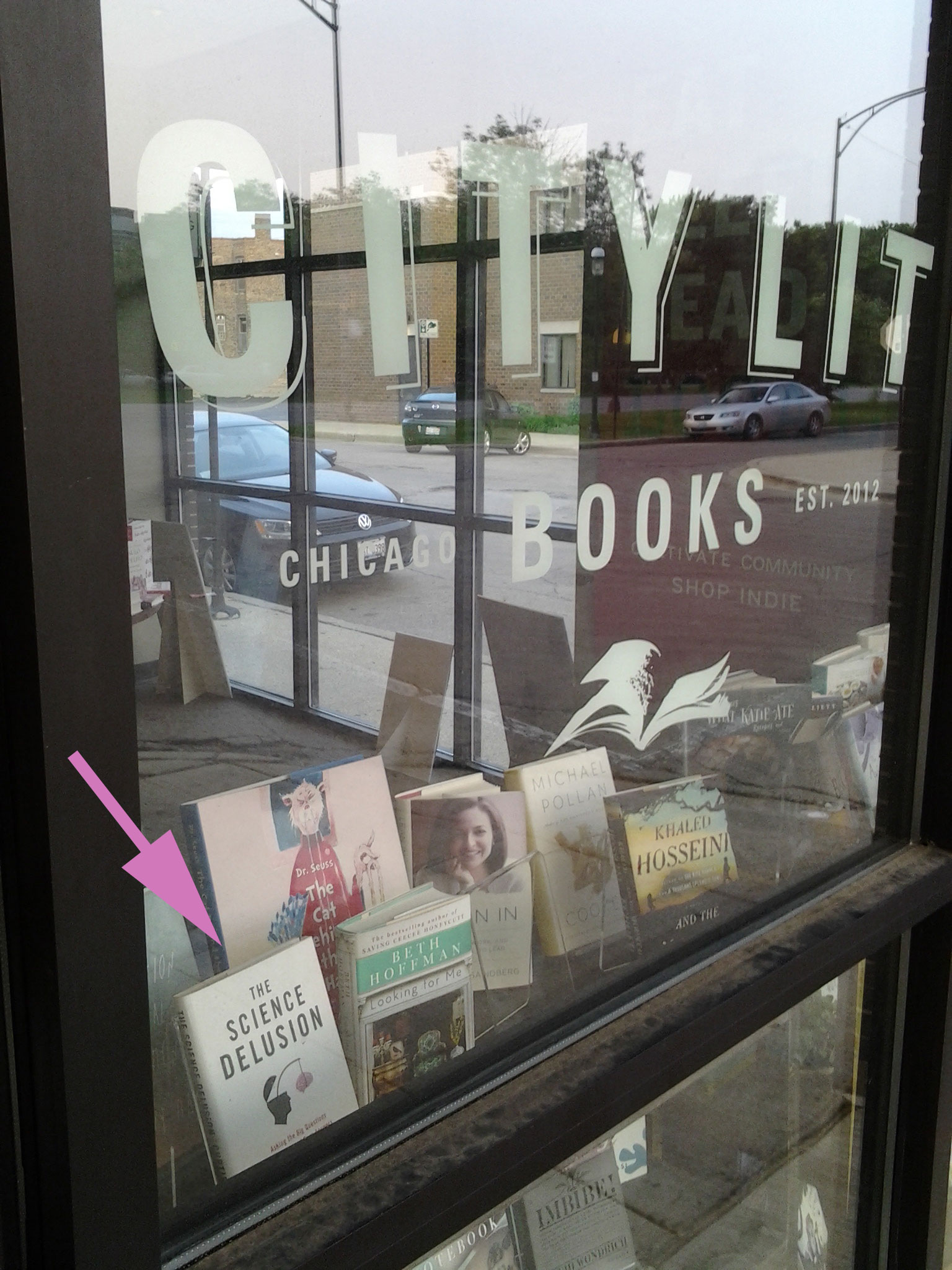In memory of Robert Ashley, 1930–2014

I first learned about Robert Ashley through Peter Greenaway, thanks to his Four American Composers series. I rented all four videos because I was interested in John Cage and Philip Glass. I didn’t know who Meredith Monk was, or Robert Ashley.
As it turns out, the episode on Ashley interested me the most. I didn’t understand the opera being discussed, Perfect Lives, but I knew I had to hear and watch the whole thing. I took to the internet and discovered that I could order it directly from Lovely Music, on VHS. I did so. It cost me $100—but I had to hear it.
Few people I knew at the time had ever heard of Robert Ashley. When I moved to Illinois and met Mark Tardi and Jeremy M. Davies, we bonded in part over our shared love for Perfect Lives, “an opera for television” made in the late 1970s and early 1980s. It’s still not widely known. It’s still never been broadcast in its entirety in the US. But I’m not alone alone in regarding it one of the greatest operas and long poems in the English language. (John Cage wrote of it: “What about the Bible? And the Koran? It doesn’t matter. We have Perfect Lives.”)
Psalm 44
 Psalm 44
Psalm 44
by Danilo Kiš
Dalkey Archive Press, 2012
128 pages / $16.95 buy from Dalkey Archive Press
Rating: 9.0
“The work of Danilo Kiš preserves the honor of literature.”
-Susan Sontag
In his Psalm 44, Danilo Kiš offers something beautiful and immediately important. The novel, set in the Auschwitz concentration camp, confronts deep tragedy.
As a writer, Kiš trends expansive, with long lyrical passages:
“She remembered the return from the village, and her perplexity at not traveling by train (the way they had come) and only then by cart through the fields of rye and poppies, but they covered the whole distance back in a cart, moving continuously alongside the tracks with their thundering haughty trains, and she loved travel by train, as did her mother, who had told her she had loved to travel by train, but just now she said she preferred to lurch along the bumpy village lanes, where there isn’t any way to shield your head and so the sun strikes you directly on the pate, right on the crown of your skull. Then they reached the city and Marija said to her mother that she’d had more than enough of this cart and that she would at least like to ride the streetcar at this pint, to ride the blue one that went from the train station straight to the corner of their street where the chestnut blossoms were…”
September 3rd, 2013 / 6:57 pm
Bornholm Night-Ferry
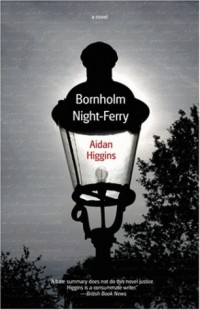 Bornholm Night-Ferry
Bornholm Night-Ferry
by Aidan Higgins
Dalkey Archive Press, 2006
175 pages / $12.95 buy from Dalkey or Amazon
Rating: 9.0
Bornholm Night-Ferry wades through inscrutable regions of a long distance relationship. Aidan Higgins is at turns wistful and heartbreaking as he chronicles this classic “end of an affair” novel.
The novel’s organizing device comes in letters between two lovers separated by a continent—one living in Ireland, the other in the Netherlands—as they flirt, cajole, complain, and desperately attempt to hold onto a brief romance. As a sweet and sad book, the novel explores well-tread ground. First published in 1983, it often recalls Annie Hall and Hopscotch in tone and aesthetic. The lovers pun and namedrop in a pseudo-gliglish patois. Larry Rivers is a central character. READ MORE >
August 1st, 2013 / 3:17 pm
Curtis White will be reading in Chicago this Thursday
At City Lit in Logan Square, at 6:30pm. Curt will be reading from his new book, The Science Delusion: Asking the Big Questions in a Culture of Easy Answers, which just came out through Melville House.
I did my Master’s degree with Curt at Illinois State University, and he’s one of the smartest and best writers I know. (He’s one of the two profs who first got me reading Viktor Shklovsky.) In the 1980s, he and Ron Sukenick transformed Fiction Collective into FC2, and I learned about FC2 (and ISU) partly through the two “sampler collections” they put out (something I wish more presses did). Curt’s also written seven works of fiction, including The Idea of Home and Memories of My Father Watching TV, and now five works of nonfiction, including his infamous attack on Terry Gross (among other things), The Middle Mind. (He may not have made Gross cry, but he sure pissed off a lot of her fans.)
I’m only halfway through this new book (and will be writing more about it later), but so far I’d describe it as an attack on the idea, currently very en vogue, that scientific knowledge is the only or most superior form of knowledge, and thus the only means of accounting for what it means to be human. Right from the start Curt shows how much of science’s own knowledge is shoddy and unexamined. For example, it’s not uncommon to hear scientists like Stephen Hawking claim that the universe is beautiful, but how do they understand beauty? Not very well, Curt argues. Like in The Spirit of Disobedience, Curt demonstrates how other intellectual traditions—specifically Romanticism, which he traces through the Beats and punk—offer a way around and past some of the more inane debates consuming so many today, such as “science vs. religion.” Plus he’s funny, too.
If you’re in Chicago this Thursday, come by and hear Curt! Discussion will follow during which you can ask him embarrassing questions.
25 Points: The Tunnel
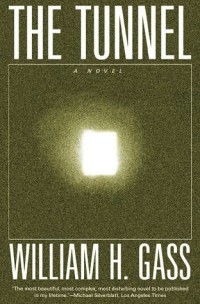 The Tunnel
The Tunnel
by William Gass
Dalkey Archive Press, 2007
652 pages / $15.95 buy from Dalkey Archive Press or Amazon
1. It took the man 26 years to write this thing. Let’s just get that out of the way now.
2. Semi-autobiographical, with an ornate use of language, penis obsessed, full of stupid limericks about horny nuns. It’s in the vein of Joyce and Pynchon but maybe not as annoying, not as smug–though maybe I’m wrong about that.
3. I did find the book unusually satisfying. Just sitting down and reading Gass’s prose out loud is really enjoyable: rhyming and alliteration are present at all points but Gass weaves the sounds into the thought and plot without being gratuitous. He does it joyously, gallopingly. He moves things along at a decent pace and lets you feel every increment.
4. The narrator William Kohler is a terrible person who you learn to love. He’s a fascist, misogynist, grumpy fat old fuck and you get to see inside his head and understand why he is all of these things. If you are the sort of person whose life can be changed by books this may change you so you can appreciate the shittiest people on this planet.
5. Plot is minimal. If anything “happens” it is the digging of the eponymous tunnel though that whole part is really pretty minor anyways. The majority of the book follows Kohler examining his childhood, his education, his marriage, family, coworkers and anger. Always the anger, the disappointment.
6. Kohler has two kids. Throughout the book he can only remember one of their names. Genius.
7. The descriptions are, without a doubt, beautiful. Candy, flowers, interiors, and people especially. Gass builds the characters up from thousands of scraps, always describing over and over, adding and sticking on and plugging holes. The characters come off as straddling an incredibly thin line between being fully developed and total caricatures. It works because we are inside Kohler’s head the whole time, and don’t you always caricature those you are forced to be around?
8. Degenerative sickness strikes a number of those around Kohler. Those he loves and hates. These depictions are gut wrenching and we get to see the characters before and during, before and during, before and during their declines. Seeing Kohler’s brilliant mentor go through sickness then back to health is particularly rough for we know that soon enough he will be back on the sick bed twitching and jerking. It’s like Gass gives them a reprieve just so he can suck them back through their crumbling one more time.
9. There is this depiction of academic life toward the beginning of the book which (though never having lived it myself) seems entirely appropriate: “Life in a Chair.” Kohler looks back and realizes he’s spent his entire life just sitting, reading, sometimes looking out a window. He never succumbs to sadness or regret, just puts it out as a solid fact and meditates on it to great length. This section should be read by anyone who wants to go into academia I think.
10. There are few people in Kohler’s life who are not totally insane. READ MORE >
May 28th, 2013 / 5:01 pm
25 Points: The Notebooks of Malte Laurids Brigge
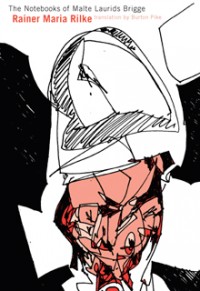 The Notebooks of Malte Laurids Brigge
The Notebooks of Malte Laurids Brigge
by Rainer Maria Rilke, translated by Burton Pike
Dalkey Archive Press, 2008
235 pages / $13.95 buy from Dalkey
1. “So this is where people come in order to live, I would rather thought: to die.” Young Malte Laurids Brigge is talking about Paris. “I have been out. I have seen: hospitals. I saw a man who tottered and collapsed. People gathered around him, that spared me the rest.”
2. Published in 1910, this is Rainer Maria Rilke’s only novel. He is considered one of the most significant poets of the twentieth century and is perhaps best known for Sonnets to Orpheus and the Duino Elegies. I was introduced to him in an undergraduate poetry workshop, taught by Peter Gizzi. He wore a beret and smoked cigarettes in class. He told me: “Read Rilke’s Letters to a Young Poet,” and so I did.
3. This is Burton Pike’s translation, issued by Dalkey Archive in 2008. It has been referred to as an “edgy” translation, a “refreshing” one that attempts to preserve the “strangeness” of the original German. Pike says: “Rilke’s prose in this novel is arresting, haunting, and beautiful, but it is not smooth…. It would be a mistake to translate his German into a smoothed-over literary English. That would be to overemphasize the existential element of Malte’s tribulations, and to obscure the radically experimental and daring nature of Rilke’s prose.”
4. The existential elements of this novel are hard to avoid, whether or not you consider this translation smooth. The preoccupations of Malte, destitute poet arriving in Paris to write, concern death and being and becoming. “The main thing was that one was alive. That was the main thing.”
5. In the city, Malte is becoming. He is “learning to see.” He says: “I don’t know why, everything penetrates me more deeply, and doesn’t stop at the place where it always used to end. There is a place in me I knew nothing about. Everything goes there now. I don’t know what goes on there.”
6. The novel is in two parts: Book One and Book Two. There are fragments and sketches and the idea of “notebooks” is apt. There are ghost stories and inanimate objects that are imbued with energy and life. Scenes from Malte’s childhood bump up against fabrications and medieval legends. It is a book that wanders and circles back on itself. It speaks of death and history and imagination. It concerns itself with fear and fever and art.
7. For the sake of poetry, Malte tells us: “One must be able to think back to paths in unknown regions, to unexpected meetings and to partings one long saw coming; to childhood days that are still not understood…. to childhood illnesses that set in so strangely with so many profound and heavy transformations, to days in quiet, muted rooms and to mornings by the sea, the sea altogether, to nights travelling that rushed up and away and flew with all the stars; and if one can think of all that, it is still not enough. One must have memories of many nights of love, none of which resembled another, of screams in the delivery room and of easy, pale, sleeping women delivered, who are closing themselves. But one must also have been with the dying, have sat by the dead in the room with the open window and the spasmodic noises.”
8. All this is necessary for poetry and Malte is in Paris to write. He is twenty-eight and “just about nothing has happened.” And so “it is still not enough to have memories,” he tells us. “One must be able to forget them, if they are many, and to have the great patience to wait for them to come again. For it is not the memories themselves. Only when they become blood in us, glance and gesture, nameless and no longer to be distinguished from ourselves, only then can it happen that in a rare hour the first word of a line arises in their midst and strides out of them.”
9. And so we are led through these scenes of memory and of historical texts and visions and legends that perhaps have become blood in him. Or are in the process of becoming.
10. In one of a series of questions Malte poses to himself and to his reader, he asks “It is possible that the whole history of the world has been misunderstood? Is it possible that the past is false because one has always spoken of its masses, as if one was telling about a coming together of many people, instead of telling about the one person they were standing around, because he was alien and died?” “Yes, it is possible.” He asks these existential, unanswerable questions, responding to each: “Yes, it is possible.” If it is possible that there are no certainties at all, no universally accepted philosophies of living and dying, then it is incumbent upon him, though “young, irrelevant” to write “day and night, he will just have to write, and that will be that.” This is the young poet’s charge. READ MORE >
February 14th, 2013 / 1:02 pm
25 Points: Wittgenstein’s Mistress
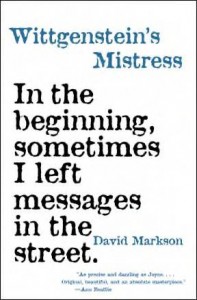 Wittgenstein’s Mistress
Wittgenstein’s Mistress
by David Markson
Dalkey Archive Press, 1988
248 pages / $16.95 buy from Dalkey
1. David Markson published Wittgenstein’s Mistress in 1988, 37 years after the death of Ludwig Wittgenstein, whose name you may recognize from the novel’s title, or from his being an eminent 20th century philosopher.
2. How is it that one earns the designation philosopher, when one could just as accurately be called a philosophy professor (see also: Martin Heidegger, Immanuel Kant, et al.; technically Nietzsche taught philology)? It may have something to do with one’s work eventually being taught by other philosophy professors.
3. Or with someone someday writing a piece of experimental fiction indebted to one’s philosophy. Perhaps it helps if the title mentions one by name.
4. Possibly it is not unhelpful if one’s mentor is someone else people call philosopher (e.g., Bertrand Russell).
5. Ludwig Wittgenstein is not a character in Wittgenstein’s Mistress.
6. Maybe that’s not right. Possibly Ludwig Wittgenstein is a character in Wittgenstein’s Mistress. As are Rembrandt and Da Vinci and William Gaddis and Helen of Troy and a scratching cat that is in fact (“in fact”) only out of sight duct tape in the wind.
7. Unquestionably, a character in Wittgenstein’s Mistress is a woman named Kate, who had a son once, who is nearing menopause, who was once an artist, who knows a lot about art and art history and philosophy and literature, much of it, she claims, gleaned from footnotes. More questionably, Kate is the only person in the world.
8. Unquestionably, she believes herself to be.
9. One of the novel’s central conceits, if it is not too reductive to talk that way, is that whether or not Kate is “actually” alone in the world is pretty beside the point. Philosophers call this problem solipsism, while the rest of us call it loneliness.
10. The novel’s own text, in the context of the novel, is the artifact of Kate’s time (of course) alone at a typewriter. Ostensibly Kate’s aloneness makes the text necessarily therapeutic, rather than communicative, since there is no one in her world with whom she could communicate. Yet here the text is—in our world—as a novel, and here we are—the readers—reading, receiving it. READ MORE >
January 15th, 2013 / 12:05 pm
25 Points: Autoportrait
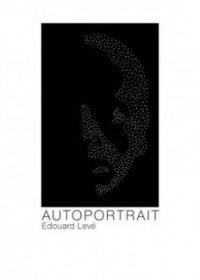 Autoportrait
Autoportrait
by Edouard Levé
Dalkey Archive Press, 2012
120 pages / $12.95 buy from Dalkey
1. I didn’t intend to write about this book until I finished it just now.
2. Today I read a speech given by Jeffrey Eugenides in which he quoted Christopher Hitchens recalling the advice of Nadine Gordimer, i.e. “A serious person should try to write posthumously.” I think Edouard Levé succeeded in writing posthumously before his death.
3. When I first read the line “I find tips humiliating for the giver and the receiver,” I initially understood “advice” rather than “gratuity.”
4. I read the musings on mortality and suicide in Autoportrait differently than the musings of characters written by other authors who later killed themselves. I’m not sure why.
5. I experienced disappointment (with myself?) whenever a line caused me to think of Twitter. (“I have thought simultaneously: ‘I really should learn the trombone’ and ‘there’s a dead ant.'”)
6. “I am writing this book on a computer, there will never be a manuscript.”
7. The thought “Oh, you too?” occurred to me around 30 times after reading different lines in the book. (“On a trip, I fold my dirty laundry so it will take up less space.” “I rest only against my will.” “At a public urinal the presence of a neighbor delays my micturition.” “I have a fantasy involving female art students.”)
8. In my opinion, the number of pairs of pants Levé owned seems excessive. (60!)
9. It would have taken me longer to pick up this book if it had been called Self-Portrait by Edward Lee. In some way I think this is similar to the author’s fondness for Levi’s 501 Jeans.
10. Probably more than 30 times I would read the first clause of a sentence and think “This is going to be good.” (“Here is how I tell the story of Jesus:…”) READ MORE >
December 27th, 2012 / 12:08 pm
25 Points: 20 Lines a Day
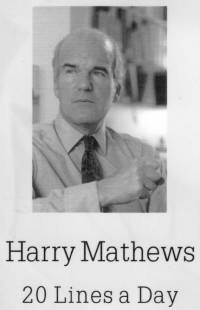 20 Lines a Day
20 Lines a Day
by Harry Mathews
Dalkey Archive Press, 1988
134 pages / $10.95 buy from Dalkey
1. In the fifth floor of the library, I picked the book up, read what the premise was, and thought resentfully, “What a bunch of bullshit, this looks boring, look how anything gets published.” I didn’t know who Harry Mathews was yet. Years ago.
2. “You never have earned the right to sit at the table and let someone else clear away the dishes. No accumulation of knowledge can guarantee that you aren’t a fool. The roast is over-cooked. You slice bread for the seven-hundredth time and cut off the tip of your left forefinger. You touch her as coarsely as any boor, being now the boor. You meet an old friend, you have forgotten his name, you cannot look him in the face: not looking him in the face, you wound him and you start lying to him and to yourself. Go off and sulk and complain and explain why it happened. It won’t help. Instead, be an actor, or an athlete, on stage, on the field, giving–as you once eagerly proposed to yourself–everything to the perishable act.”
3. “I have nothing to write in particular, I’m writing these lines because of my rule that I must write them.”
4. Some writers set quotas, others set routines, some set both, and some (the scriptomanic ones for whom procrastination is not a threat) set neither. A page a day (Paul Theroux); 50,000 words in a month (NaNoWriMo); two hours every morning (W.S. Maugham); 20 minute blocks (Cory Doctorow); at least a sentence a day (W.G. Sebald); pre-dawn (Paul Valéry, Jacques Roubaud); etc.
5. “Whatever I write tells my story without my knowing it.”
6. “Let no thought pass incognito, and keep your notebook as strictly as the authorities keep their register of aliens.” (Walter Benjamin, “One Way Street,” Reflections)
7. “Sometimes the ultimate message is in fact received. It reads, more or less: ‘Your ligament issues from a spa that is given various narcissisms at various time-tables: lozenge, credulity, goggles. And not only your ligament (and that of others): the prodigy that generates mayday has the same orthography. You and the upkeep are one. Give up sugarbowls.’ At such moments you realize, and you remember, that such messages have never been lacking, and that they are all the same, and that the problem (if that is the word) doesn’t involve receiving but deciphering what is received again and again, day after day, minute after minute.”
8. There’s an implicit link between 20 Lines a Day and the next novel Mathews would publish, The Journalist (1994). One sees how the method Mathews followed for 20 Lines is adopted as a fictional premise and device for The Journalist.
9. “Anxiety about writing feels like: I am poor in words, ideas, and feelings, and when I sit down to write, this poverty will be revealed.”
10. “The table is a beautiful thing. The writing board is supported on a base consisting of two tubular legs shaped like narrow inverted U’s, with a tubular foot running across the mouth of each U, projecting about thirty centimeters beyond it on either side. The legs are connected to the board by an adjustable parallelogram made of bone-shaped pieces of flat metal. The knobs of the bones are pierced with pivotal studs that hold the sides of the parallelogram together. Two strong springs, to hold the angles in place, maintain pressure against two other springs fixed just below the board. A single lever controls this disposition and locks the board in place. Changing the angles of the parallelogram permits one to alter both the height and angle of the board in one movement. Board, parallelogram, legs and feet are white; springs, studs, and lever handle are black.” READ MORE >
October 25th, 2012 / 9:09 am
Great First Lines: “Rose Alley” by Jeremy M. Davies
They shot her screen test in Paris, where I’ve never been, in the private room of the café Tout Va Bien, in the Latin Quarter, newly paved in tar, and still lewd that winter with debris from the blockades of stacked cobblestones—centuries old, pried right off the streets—and the stink of some secret catastrophe.
A disclaimer: Jeremy’s a dear friend and former roommate of mine—but c’mon! That opening line is obviously great. & the whole book is simply fabulous. I was motivated to post this because I just recommended, for the dozenth time, no joke, that a fellow writing classmate read the book …
So what’s going on in this opening line?

